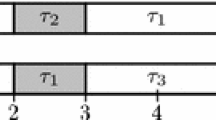Abstract
All intrinsic properties of the earliest deadline taks scheduling discipline are compiled and discussed in order to show that this is the most advantageous scheme at hand, characterised by efficiency and allowing predictable system behaviour. It is then pointed out how the method naturally extends to the scheduling of tasks having non-pre-emptable regions due to resource access constraints. A sufficient condition is derived, which allows, at any arbitrary point in time and under observation of resource constraints, to check the feasible schedulability of the tasks competing for processor allocation. This condition applies to entirely non-pre-emptable tasks as well. Taking the corresponding overhead into consideration, the circumstances are characterised under which the task context-switches imposed by the scheduling algorithm can be avoided. Favourable consequences of deadline scheduling for virtual storage management are mentioned. Finally, application oriented schemes for coping with transient overloads and thus allowing load adaptive dynamic scheduling are introduced. Such overloads can be easily detected at an early stage utilising the here established schedulability criterion.
Zusammenfassung
Durch Zusammenstellung und Diskussion ihrer Struktureigenschaften wird gezeigt, daß die Antwortzeit-steuerung das vorteilhafteste und effizienteste Prozessorzuteilungsverfahren ist. Insbesondere läßt es zu, das Systemverhalten vorhersehbar zu gestalten. Der Algorithmus kann ganz natürlich auf die Zuteilung sequentieller Prozesse ausgeweitet werden, die auf Grund von Betriebsmittelreservierungen nichtunter-brechbare Regionen besitzen. Es wird eine hinreichende Bedingung abgeleitet, die zu jeder Zeit und unter Beachtung der Betriebsmittelzugriffsrechte die zeitgerechte Verarbeitbarkeit der um die Zuweisung des Prozessors konkurrierenden Tasks zu überprüfen erlaubt. Diese Bedingung gilt ebenfalls für überhaupt nicht unterbrechbare, Tasks. Unter Berücksichtigung des Aufwandes für Task-Wechsel werden diejenigen Situationen charakterisiert, in denen die durch den Zuteilungsalgorithmus vorgegebenen Prozeßwechsel vermieden werden können. Als günstigen, Nebeneffekt ermöglicht die Antwortzeitsteuerung die vorausschauende Verwaltung virtueller Speicher. Abschließend werden anwendungs-orientierte Überlasthandhabungsverfahren vorgestellt. Sie erlauben lastabhängige, adaptive und dynamische Zuteilung auf der Grundlage des Kriteriums zur zeitgerechten Verarbeitbarkeit, das zukünftige Überlastfälle so frühzeitig wie möglich zu erkennen gestattet.
Similar content being viewed by others
Explore related subjects
Discover the latest articles, news and stories from top researchers in related subjects.References
Chung, J. Y., Liu, J. W. S., Lin, K. J.: Scheduling periodic jobs using imprecise results. Technical Report No. UIUCDCS-R-87-1307, Department of Computer Science, University of Illinois, Urbana, IL, November 1987.
Henn, R.: Deterministische Modelle für die Prozessorzuteilung in einer harten Realzeit-Umgebung. PhD Thesis, Technical University Munich, 1975.
Henn, R., Zeitgerechte Prozessorzuteilung in einer harten Realzeit-Umgebung. GI-6. Jahrestagung, pp. 343–359. Informatik-Fachberichte 5, Berlin, Heidelberg, New York, Tokyo: Springer 1976.
Henn, R.: Antwortzeitgesteuerte Prozessorzuteilung unter strengen Zeitbedingungen. Computing19, 209–220 (1978).
Henn, R.: Feasible processor allocation in a hard-real-time environment. The Journal of Real-Time Systems1, 77–93 (1989).
Johnson, H. H., Maddison, M.: Deadline scheduling for a real-time multiprocessor. Eurocomp. Conf. Proceedings, pp. 139–153 (1974).
Labetoulle, J.: Ordonnancement des processus temps reel sur une ressource pre-emptive. These de 3me cycle, Universite Paris VI, 1974.
Labetoulle, J.: Real time scheduling in a multiprocessor environment. IRIA Laboria, Rocquencourt, 1976.
Lin, K. J., Natarajan, S., Liu, J. W. S., Krauskopf, T.: Concord: a system of imprecise computations. Proc. 1987 IEEE COMPSAC Conference, Tokyo, October 1987.
Lin, K. J., Natarajan, S., Liu, J. W. S.: Imprecise results: utilizing partial computations in real-time systems. Proc. IEEE Real-Time Systems Symposium, San Jose, CA, December 1987.
Liu, C. L., Layland, J. W.: Scheduling algorithms for multiprogramming in a hard-real-time environment. JACM20, 46–61 (1973).
Liu, J. W. S., Liu, K. J., Natarajan, S.: Scheduling real-time, periodic jobs using imprecise results. Proc. IEEE Real-Time Systems Symposium, San Jose, CA, December 1987.
Schrott, G.: Ein Zuteilungsmodell für Multiprozessor-Echtzeitsysteme. PhD Thesis, Technical University Munich, 1986.
Sha, L., Rajkumar, R., Son, S., Chang, C.-H.: A real-time locking protocol. To appear in IEEE Trans. Comput.
Author information
Authors and Affiliations
Rights and permissions
About this article
Cite this article
Halang, W.A. Load adaptive dynamic scheduling of tasks with hard deadlines useful for industrial applications. Computing 47, 199–213 (1992). https://doi.org/10.1007/BF02320192
Received:
Revised:
Issue Date:
DOI: https://doi.org/10.1007/BF02320192




